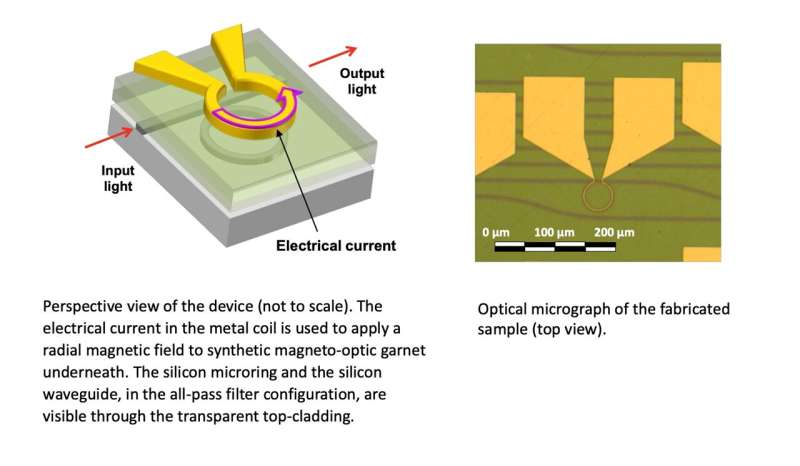September 26, 2022 feature
A magneto-optic modulator could facilitate the development of next-generation superconductor-based computers

In the future, many computers will most likely be based on electronic circuits made of superconductors. These are materials through which an electrical current can flow without energy losses, could be very promising for the development of high-performance supercomputers and quantum computers.
Researchers at University of California Santa Barbara, Raytheon BBN Technologies, University of Cagliari, Microsoft Research, and the Tokyo Institute of Technology have recently developed a magneto-optic modulator—a device that control the properties of a light beam through a magnetic field. This device, introduced in a paper published in Nature Electronics, could contribute to the implementation of large-scale electronics and computers based on superconductors.
"We are working on a new technology that can speed up high-performance supercomputers and quantum computers based on superconductor technology," Paolo Pintus, the researcher who led the study, told TechXplore. "Superconductors work properly only at low temperatures, generally just above absolute zero (-273.15° Celsius). Because of this, circuits made of these materials must be kept inside a dedicated refrigerator."
Circuits made of superconductors are typically connected to their external surroundings using metal cables. These cables have a limited communication speed and can transfer heat into a cold circuit.
A promising alternative would be to use optical fibers, thin and flexible glass wires that can convey light signals and are currently used to bring internet data over long distances. These fibers offer two main advantages over metal cables: they can transmit 1,000 times more data within the same period of time without transferring heat, since glass is a good thermal insulator.
"As part of our work, we designed and fabricated a device (known as 'optical modulator') that converts information carried by an electrical current in an electromagnet into light," Pintus explained. "This is thanks to a physical mechanism called 'magneto-optic effect.' This light can travel through an optical fiber and carry information out of the cold environment, without altering the functionality of the cold circuit."
Optical modulators such as the device created by Pintus and his colleagues allow researchers to control the properties of light beams, so that they can transfer information in the form of optical signals. These modulators have numerous potential applications, for instance allowing the transmission of binary (one and zero) codes over long distances.
The magneto-optic modulator created by the researchers uses an electrical current to generate a magnetic field. This magnetic field in turn induces a change in the optical properties of a synthetic garnet where light is propagating.
"The mechanism underpinning our modulator is analogous to a guitar player who changes the stiffness of the strings to play a different sound," Pintus said. "In our case, the magnetic field controls the optical density of the medium where the light is traveling, such that when the light can propagate, we get a '1,' and when the light is attenuated, we have a '0.'"
In initial evaluations, the magneto-optic modulator created by Pintus and his colleagues achieved highly promising results. Most notably, it reached a relatively fast modulation speed (a few Gigabits per second) and could operate at temperatures as low as 4 K (-269.15° Celsius).

"This is the key component to enable energy-efficient large data transfer rate from superconducting circuits, operating inside a cryostat at low temperature, and room temperature," Pintus said. "Normally, optical modulators are based on a few electro-optic effects, where an electric field changes the optical property of the material where the light is propagating. The magneto-optic effect that we used, on the other hand, is a dual effect, where a magnetic field changes the optical property of a medium."
Although the magneto-optic effect is well-known and extensively studied, Pintus and his colleagues were among the few who investigated its potential value for creating modulators. This area had not been explored much before because manufacturing integrated magneto-optic devices and applying fast time-variant magnetic fields can be very challenging. In addition, the magneto-optic effect tends to be associated with significantly slower response times than electro-optic effects.
"Ours is the first proof of concept of a high-speed modulator based on a magneto-optic effect," Pintus said. "With this modulator, we demonstrate a key building block to enable effective communication between cryogenic environment and room-temperature electronics using optical fibers. Compared to previous cryogenic (electro-optic) modulators, our proposed solution has a very simple structure and it is compatible with superconducting circuits, since the input electrical impedance is very small."
The promising performance and cryogenic nature of the researchers' modulator make it suitable for connecting standard electronics (at room temperature) with cryogenic superconducting and quantum computing architecture. In the future, this recent study could pave the way for new research focusing on magneto-optic materials for optical modulation and on their potential computing applications.
"In our work, we demonstrated a modulation rate of 2 Gigabit-per-second with energy consumption below 4 picojoule-per-bit of transferred information, which could be reduced by 80 times (below 50 femtojoule-per-bit) by optimizing the fabrication process in the same material system," Pintus added. "Although this performance is impressive, we believe there is a lot of room for further improvements. In our next works, we would like to explore other materials to achieve higher modulation rate and lower power consumption. The field of cryogenic magneto-optic material is an unexplored area and it will take more investigation to narrow down the most promising materials."
More information: Paolo Pintus et al, An integrated magneto-optic modulator for cryogenic applications, Nature Electronics (2022). DOI: 10.1038/s41928-022-00823-w
© 2022 Science X Network




















